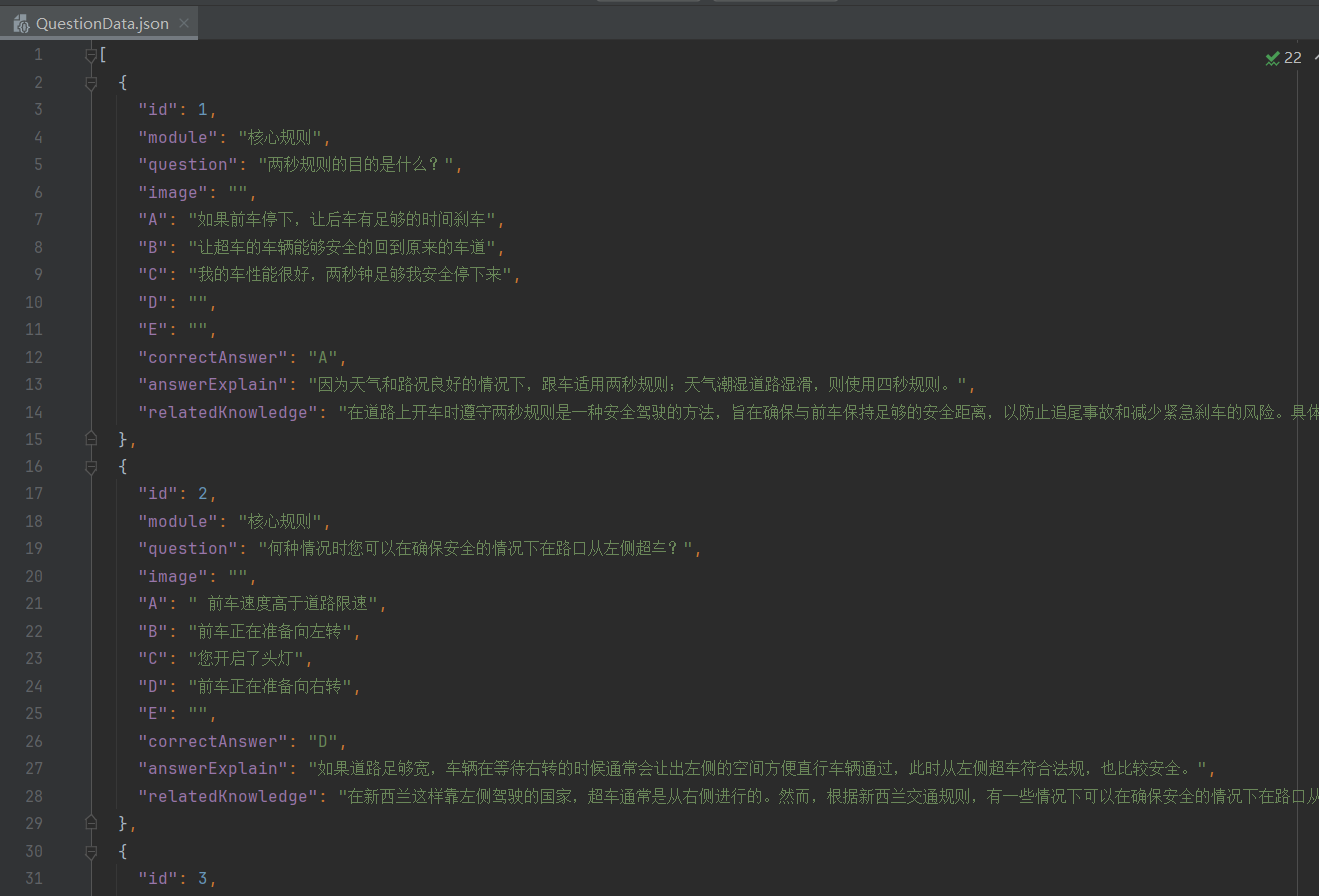HarmonyOS 鸿蒙Next BufferUtil.ets的工具类和resourceManager获取Json文件数据集
HarmonyOS 鸿蒙Next BufferUtil.ets的工具类和resourceManager获取Json文件数据集
1.首先可以把准备好的数据已Json文件的格式存储好,通过鸿蒙应用开发提供的工具转化成字符串类型,如下BufferUtil.ets的工具类方法代码:
import { util } from ‘@kit.ArkTS’;
export function bufferToString(buffer: ArrayBufferLike): string {
let textDecoder = util.TextDecoder.create(‘utf-8’, {
ignoreBOM: true
});
let resultPut = textDecoder.decodeToString(new Uint8Array(buffer), {
stream: true
});
return resultPut;
}
2.然后导入这个工具方法到组件页面,调用这个工具类方法去读取你的JSON文件。当然下面的数据TrafficRuleMenu[]是一个根据Json文件的数据定义好的数据类。
这里涉及到Context的概念和常见使用场景,Context是应用中对象的上下文,其提供了应用的一些基础信息,具体有兴趣可以参考这篇文章 https://mp.weixin.qq.com/s/1fNSkQnJnV4xEnXonbat-g
getMenuDataFromJSON() {
getContext(this).resourceManager.getRawFileContent(‘MenuData.json’).then(value => {
this.menuList = JSON.parse(bufferToString(value.buffer)) as TrafficRulesMenu[];
})
}
Json文件格式如下面图片所示:

根据Json文件里面数据定义好的数据类如下:
export class QuestionsClass {
public id: number
public module: string
public question: string
public image: string
public A: string
public B: string
public correctAnswer: string
public answerExplain: string
public relatedKnowledge: string
public C?: string
public D?: string
public E?: string
public image_A?: string
public image_B?: string
public image_C?: string
public image_D?: string
public image_E?: string
public userAnswer?: string
constructor(id: number, module: string, question: string, image: string, A: string, B: string, correctAnswer: string,
answerExplain: string, relatedKnowledge: string, C?: string, D?: string, E?: string, image_A?: string,
image_B?: string, image_C?: string, image_D?: string, image_E?: string, userAnswer?:string) {
this.id = id;
this.module = module;
this.question = question;
this.image = image;
this.A = A;
this.B = B;
this.C = C;
this.D = D;
this.E = E;
this.correctAnswer = correctAnswer;
this.answerExplain = answerExplain;
this.relatedKnowledge = relatedKnowledge;
this.image_A = image_A;
this.image_B = image_B;
this.image_C = image_C;
this.image_D = image_D;
this.image_E = image_E;
this.userAnswer = userAnswer
}
CheckQuestion(correctAnswer:string,userAnswer:string){
if(correctAnswer == userAnswer) return true;
else return false;
}
}
更多关于HarmonyOS 鸿蒙Next BufferUtil.ets的工具类和resourceManager获取Json文件数据集的实战系列教程也可以访问 https://www.itying.com/category-93-b0.html
更多关于HarmonyOS 鸿蒙Next BufferUtil.ets的工具类和resourceManager获取Json文件数据集的实战系列教程也可以访问 https://www.itying.com/category-93-b0.html
在HarmonyOS鸿蒙系统中,Next BufferUtil.ets 工具类和 resourceManager 是用于处理数据和资源管理的重要组件。针对你提到的 Next BufferUtil.ets 工具类获取数据以及 resourceManager 获取 JSON 文件数据集的问题,以下是简要说明:
Next BufferUtil.ets 工具类主要用于缓冲区操作,虽然具体实现细节未提供,但通常这类工具类会包含对缓冲区数据的读取、写入、转换等功能。如果你需要利用它来处理数据,通常需要先确保数据已正确加载到缓冲区中,然后调用相应的方法进行操作。
而 resourceManager 是鸿蒙系统中用于访问和管理应用资源的组件。要获取 JSON 文件数据集,你可以通过 resourceManager 提供的 API 来定位并加载 JSON 文件。加载后,你可能需要使用 JSON 解析库来解析文件内容,将其转换为可操作的数据结构(如 Map 或自定义对象)。
具体实现时,你需要查阅鸿蒙系统的官方文档或 API 参考,了解 Next BufferUtil.ets 和 resourceManager 的详细用法及参数。
如果问题依旧没法解决请联系官网客服,官网地址是:https://www.itying.com/category-93-b0.html








